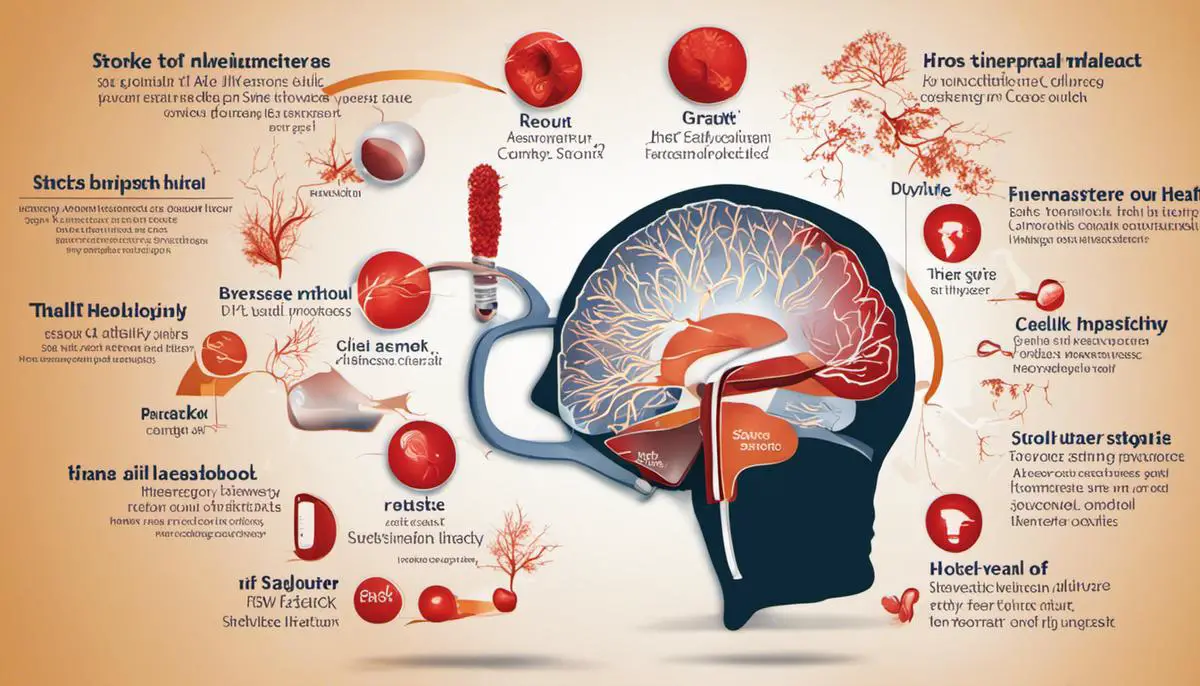Stroke is an alarming health concern that poses severe risks to overall well-being and quality of life, with devastating impacts both physically and psychologically. Grounded in complex medical science, strokes occur when the supply of blood to the brain is either interrupted or reduced. This deprivation of essential nutrients and oxygen can trigger rapid damage to the brain cells – an area often associated with long-term disability or even death. Indeed, studies confirm the intimidating prevalence of stroke, asserting the urgency to comprehend and tackle this issue effectively. As such, comprehending the risk factors, which span from genetic predisposition to lifestyle habits, warrants our attention. By recognizing the significance of dietary choices, physical activity, routine health checks, and mental wellness, we stand a better chance of mitigating these risks. Remember, these changes are not merely about defying the odds of having a stroke but about endorsing a healthier, more fulfilling lifestyle.
Understanding Strokes and their Impact on Health
Understanding Strokes and Their Impact on Health
A stroke occurs when the blood supply to a part of the brain is cut off or significantly reduced, which leads to an acute loss of brain function. The severity of strokes can range from temporary or mild to permanent damage, often leading to death. Every year, about 795,000 people in the United States experience a new or recurrent stroke. Out of these, approximately 140,000 people die, making stroke the fifth leading cause of death and a leading cause of adult disability in the country.
Lifestyle Changes for Stroke Prevention
Adopting certain lifestyle changes can significantly reduce the risk of stroke. These include maintaining a healthy weight, quitting smoking, and moderating alcohol consumption. Eating a diet rich in fruits, vegetables, whole grains, lean proteins and low-fat dairy can aid in maintaining a healthy weight and reducing stroke risk. Smoking, even in moderation, increases the chances of clot formation and should therefore be avoided. Limiting alcohol to moderate levels is also advisable, as excessive consumption can lead to high blood pressure and other health issues that increase the stroke risk.
Physical Activity and Stroke Risk
Engaging in regular physical activity is another crucial aspect of stoke prevention. It contributes positively to weight control, lowers blood pressure, improves blood lipid profiles, and enhances the health of blood vessels and the heart. Ideally, adults should aim for a minimum of 150 minutes of moderate-intensity aerobic exercise or 75 minutes of vigorous-intensity activity per week, along with muscle-strengthening exercises on two or more days per week.
Medical Conditions and Stroke Risk
Certain conditions dramatically increase the risk of stroke, such as high blood pressure, diabetes, and high cholesterol. It is essential to effectively manage these conditions under the guidance of healthcare professionals. As a preventive measure, anyone over the age of 18 should have their blood pressure checked regularly. Diabetic patients should routinely monitor and manage their blood sugar levels, while individuals with high cholesterol are advised to follow a diet low in saturated fats, trans fats, and cholesterol and adopt a consistent exercise regimen.
Understanding Stroke Risks and Prevention
When discussing stroke risk, factors such as age, gender, race, and family history are often mentioned. These aspects can’t be changed, but their influence on the likelihood of suffering a stroke is significant. Although one cannot alter these genetic factors, it is possible to counteract their effects. By proactively taking prescribed medications for pre-existing health conditions, adhering to a wholesome lifestyle, and undergoing regular health check-ups, you can significantly reduce your risk of experiencing a stroke. Stroke prevention should be seen as a lifelong commitment, with preventive measures taken consistently and in a timely manner, rather than acting in response to an adverse event.

Identifying Risk Factors for Stroke
Many of the risk factors associated with stroke are divided into two categories: those that are alterable and can be controlled or treated, and those that are permanent. In the latter category fall age, race, gender, and genetic predisposition. As one grows older, the likelihood of suffering a stroke increases. Generally, men are believed to be at a higher risk for stroke than women, but this disparity lessens as age progresses. Certain racial groups, such as African-Americans, have been noted to have a higher stroke incidence compared to others. However, understanding and managing the modifiable risk factors can offer some degree of protection against stroke, mitigating the influence of these fixed risk factors.
However, a majority of stroke risk factors can be changed, treated, or controlled. Lifestyle changes and medical management are effective ways to reduce stroke risk significantly.
Unhealthy habits, including poor diet, lack of physical activity, smoking and alcohol consumption, substantially contribute to stroke risk. A diet high in trans fats, cholesterol, sodium and sugar can contribute to obesity and high blood pressure, both of which are leading causes of stroke. Lack of physical activity only compounds these effects by contributing to obesity, high blood pressure, and other unhealthy conditions. Smoking raises the risk of stroke by promoting clot formation, reducing oxygen in the bloodstream, and inflaming blood vessels.
Making lifestyle changes can mitigate these risks. Following a balanced diet can lower cholesterol and blood pressure, thereby reducing the risk of stroke. This includes regular intake of fruits, veggies, whole grains, and lean proteins, along with reducing sodium and sugar.
Exercising regularly is one of the best ways to reduce stroke risk. Physical activity helps to lower blood pressure, increase good cholesterol levels, reduce bad cholesterol, improve circulation, and keep weight at a healthy level.
Smokers can significantly reduce their stroke risk by quitting, as the risk begins to decrease almost immediately after stopping and continues to lower over time.
Genetics also play a role in stroke risk. There are certain inherited disorders that can elevate the risk of stroke, including sickle cell disease. However, even if there is a family history of stroke, it doesn’t guarantee someone will have one. By addressing modifiable risk factors, people can significantly lower their risk of stroke.
Regular check-ups are a crucial component of a preventative lifestyle. Through blood tests, blood pressure readings, and discussions about personal and family health history, physicians can identify high-risk individuals, helping them make further lifestyle modifications to reduce risk. While some people exhibiting high-risk factors might require medication, many can mitigate their risk with lifestyle changes alone.
Recent studies have suggested that mental health could also play a role in stroke risk. Chronic stress, depression and anxiety can potentially increase the risk for stroke. Therefore, it is important to address mental well-being as part of a comprehensive approach to stroke prevention. This might include stress management techniques, therapy, or medication.
In summary, implementing various lifestyle changes can greatly decrease the risk of a stroke, even for individuals who have unavoidable risk factors. Regular physical activity, maintaining a balanced diet, quitting the usage of tobacco, and effectively managing stress are all vital steps in stroke prevention. Furthermore, consistent medical check-ups can help identify any potential risk factors early on, enabling the early introduction of beneficial interventions. By understanding and acting upon these risk factors, one can significantly improve their chances of preventing a stroke.

Nutritional Changes to Reduce Stroke Risk
The Importance of a Healthy Diet in Preventing Stroke
The food choices we make play a crucial role in stroke prevention. Studies have shown that specific diets and individual food items can either increase or decrease our stroke risk. Consequently, it is essential to educate ourselves about these effects to better understand how our diet can impact our overall health.
Balanced Diet Benefits
A balanced diet, rich in fruits and vegetables, lean proteins, and healthy fats, can greatly reduce the risk of stroke. These foods contain a high amount of vital nutrients like fiber, omega-3 fatty acids, and antioxidants. They can lower blood pressure and cholesterol, the risk factors of stroke. Foods such as fatty fish, berries, citrus fruits, nuts, seeds, and leafy greens are a vital part of a balanced diet that can contribute to better cardiovascular health.
Specific Foods to Prevent Stroke
Certain foods have been scientifically proven to reduce the risk of stroke. These include blueberries and oranges due to their antioxidant properties, oily fish like mackerel and salmon, which are rich in beneficial omega-3 fatty acids, and whole grains that are high in dietary fiber. Consuming a variety of these types of food can offer a comprehensive approach to stroke prevention.
Obesity, Diabetes, and Stroke Risk
Managing diet-related conditions like obesity and diabetes is a crucial component in reducing stroke risk. People living with obesity or diabetes often have higher cholesterol and blood pressure levels, increasing their likelihood of stroke. A diet high in fibers, lean proteins, and low in sugars and processed foods can help manage these conditions, thereby reducing stroke risk. Regular physical activity is also recommended to maintain a healthy weight and manage blood sugar levels.
Practical Tips on Healthier Food Habits
Adopting healthier food habits can drive you towards a lifestyle that reduces stroke risk. It’s advisable to select food low in salt and bad cholesterol, effectively controlling blood pressure and cholesterol levels. Incorporate more fresh fruits, vegetables, whole grains, and lean proteins into your diet. Limit sugary beverages and alcohol consumption as excessive intake can contribute to weight gain, high blood pressure, and ultimately, increase stroke risk.
Lifestyle Changes beyond Diet
Diet is only one aspect of a healthy lifestyle. Alongside a balanced meal plan, regular physical activity, quitting smoking, and reducing alcohol intake are powerful lifestyle changes that can decrease your stroke risk. It’s crucial to consult with physicians or dieticians to devise a comprehensive plan that takes all these factors into account, ensuring a holistic approach toward stroke prevention.
Conclusion
Making deliberate efforts to inculcate healthier habits into your daily routine could significantly decrease your chances of having a stroke. This could involve refining your nutrition plans and incorporating regular physical exercises into your schedule. A balanced lifestyle is a key factor in preventing strokes, and making these changes can greatly influence your overall well-being. However, it’s advisable to consult with your healthcare provider before making any drastic changes to your diet or lifestyle.

Exercise and Physical Activity to Lower Stroke Risk
Enhancing Stroke Prevention through Regular Exercise
Exercise plays a cardinal role in mitigating stroke risks. Engaging in consistent, moderate-intensity physical activities enhances the health of your heart and lungs—an important aspect that should not be overlooked when it comes to stroke prevention. Regular workouts aid in the management of physical health conditions tied to stroke risk, such as hypertension and obesity. By integrating routine physical exercises into your lifestyle, you substantially lower your odds of experiencing a stroke.
Choosing Suitable Types of Exercise
The type of exercise you choose largely depends on your personal preference, physical condition, and age. Aerobic exercises like walking, swimming, and cycling are excellent for improving heart health and reducing blood pressure, a significant risk factor for stroke. Strength training can also help manage weight and prevent obesity, another contributor to stroke risk. Balance and stretching exercises can help prevent falls and injuries, especially for older individuals.
For younger individuals and those in good physical condition, more vigorous aerobic exercises like running or high-intensity interval training (HIIT) can provide additional health benefits. However, it is essential to approach any new exercise regimen with caution and preferably under the advice of a physician.
Moderate and Regular Exercise Regimen
The key to reaping the health benefits of exercise is consistency. Regular, moderate exercise is better than occasional, intense exertion. The American Heart Association recommends at least 150 minutes of moderate-intensity aerobic activity or 75 minutes of vigorous-intensity activity per week. Additionally, they suggest two or more days of muscle-strengthening activities that involve all major muscle groups per week.
Managing Blood Pressure and Weight with Exercise
Maintaining a healthy weight and keeping blood pressure under control are critical elements in stroke prevention. Regular exercise can help manage both. The relationship between exercise and blood pressure is direct – when you exercise, the heart uses oxygen more efficiently, and the force on the arteries decreases, lowering blood pressure. Similarly, regular exercise helps maintain a healthy weight, which, in turn, reduces strain on the heart and blood pressure and prevents the build-up of plaques in the arteries, a major cause of stroke.
Making Exercise a Part of Everyday Life
Making exercise a regular part of your daily routine can be a simple yet highly beneficial way to boost your overall activity level. Simple changes like opting for the stairs over the elevator, parking further away to incorporate a little extra walking, or scheduling brief exercise breaks throughout your day can have a significant impact. Stand up and move around periodically, especially if your job involves prolonged sitting. These easy-to-implement changes can help reduce your risk of suffering a stroke.

Role of Regular Check-ups and Mental Health in Stroke Prevention
Scheduling Regular Health Checkups for Stroke Prevention
Scheduling routine health checkups is crucial for managing and preventing conditions that increase stroke risk. These appointments allow your healthcare provider to monitor vital health indicators like blood pressure, cholesterol, and glucose levels. Hypertension, high cholesterol, and diabetes are all major stroke risk factors. Regular health checkups facilitate early detection and improved management of these conditions, thereby reducing stroke risk.
In addition to overseeing your health, scheduled checkups also let healthcare providers review medication routines for any changes that might be necessary. Ensuring prescribed medicines are taken correctly and potentially harmful ones are closely regulated is a crucial aspect of stroke prevention. Checkups also provide the opportunity to discuss any unusual symptoms like sudden headaches, vision issues or balance problems as these could signal a heightened stroke risk. Proactive healthcare management enables early intervention and the implementation of preventive measures, decreasing the risk of a stroke.
The Impact of Stress and Mental Health on Stroke Risk
Stress and mental health significantly impact stroke risk. Chronic stress increases the body’s inflammatory and immune responses, raising blood pressure and affecting blood vessel function. Over time, this increases the chance of blood clots forming in the brain, potentially leading to stroke.
Various mental health disorders, ranging from depression, anxiety disorders to post-traumatic stress disorder (PTSD), correlate with a higher risk of stroke. People with these disorders are often at a higher risk for other health problems, such as hypertension, high cholesterol, and obesity, which also play a key role in increasing stroke risk. Research has shown that depression is associated with a 45% increased risk of stroke in adults.
Healthy Mind for Stroke Prevention
Maintaining a healthy mind contributes significantly to overall wellness and stroke prevention. Techniques such as mindfulness meditation, yoga, deep breathing exercises, and progressive muscle relaxation can lower stress levels, thereby reducing stroke risk. Guided imagery or visualization is another relaxation technique that involves forming mental images to take a visual journey to a peaceful, calming place or situation to reduce stress levels.
Cognitive Behavioral Therapy (CBT) has shown promise in treating mental health disorders. By working with a therapist, patients can learn to understand and change thought patterns that lead to harmful behaviors or emotions, thereby improving mental health and potentially reducing stroke risk.
Moreover, adopting healthy lifestyle habits, such as a balanced diet, regular exercise, adequate sleep, and abstaining from alcohol and tobacco, can significantly improve both mental and physical health, thus reducing the risk of stroke. Social engagement, pursuing hobbies, and nurturing relationships also contribute to a healthy mind, which in turn promotes overall health and wellness.
In conclusion
Regular health checkups, managing stress, maintaining good mental health, and adopting a healthy lifestyle are potent strategies for reducing stroke risk. Both physical and mental health measures contribute towards overall wellness and must be given equal importance in stroke risk reduction efforts.

Embracing a lifestyle that promotes optimal cardiovascular health is imperative in our unwavering quest to thwart strokes. Dietary modifications that prioritize balance and nutrition, coupled with a commitment to regular physical activity, pave the way towards this objective. Moreover, keeping up with consistent health checkups to screen prevalent conditions and staying abreast of one’s mental well-being serve as comprehensive preventive measures. Although certain genetic factors lie beyond our realm of control, we still wield substantial power over many modifiable aspects that profoundly influence stroke risk. Let us utilize this knowledge and undertake the necessary transformations in our lifestyles – not just to forestall strokes, but to substantiate the prospect of a healthier, longer, and more dynamic life.
